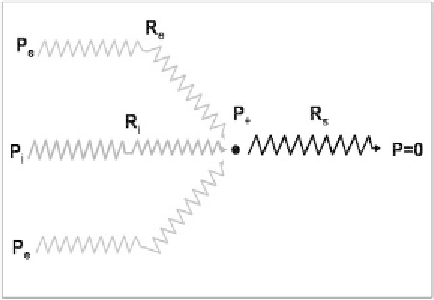Biomedical Engineering Reference
In-Depth Information
used; in other words, the polymeric solution is highly viscous. Viscosity can reach
2500 times that of water; however droplets are still being produced by the FFD. We
analyze next the behavior of highly viscous flows in FFDs, especially the alginate
solution, which viscosity has been described for in Chapter 2.
4.4.4.1 High-Viscosity Fluids in a MFFD
In this section we derive a relation between the flow rates and the driving pressures
of alginate and oil flow.
Model
Using the notations of Figure 4.71 and the hydraulic resistances of each branch (
R
e
,
R
i
,
R
s
), the pressure drops in each branch can be written under the form
P
-
P
=
R Q
e
+
e
e
P P
-
=
R Q
(4.105)
i
+
i
i
P
=
R Q Q f Q Q
(2
+
) (
)
+
s
e
i
i
e
where
f
is a function of the ratio
Q
i
/
Q
e
, which takes into account the increase of
pressure drop due to the droplet flow in the outlet channel [39, 40]. We have made
the assumption that the pressure at the intersection
P
+
is not fluctuating much; this
assumption is justified by the experimental results. Denoting
q
*
=
Q
i
/
Q
e
and
p
*
=
P
i
/
P
e
, the solution of (4.105) is
*
p C
(
+
2) 2
-
*
q
=
*
(1
+
D p
)
-
R
e
C
=
(4.106)
R f
s
R
i
D
=
R f
s
Figure 4.71
Sketch of the hydraulic resistances of the different branches of the FFD. The indices
i
,
e
, and
s
, stand for internal (alginate) phase, external (oil) phase, and outlet.




